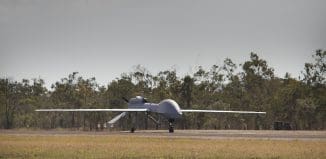Swiss Involvement in Military Developments – More than You Think
This post is also available in:  עברית (Hebrew)
עברית (Hebrew)
Swiss academic institutions maintain special relations with the US Defense Advanced Research Projects Agency (DARPA), participating in various projects funded by this American agency.
DARPA’s first gigapixel (one billion pixels) surveillance camera project ARGUS-IS (Autonomous Real-Time Ground Ubiquitous Surveillance Imaging System) might be an example. Meant to be mounted on drones, the cameras could scan an area half the size of Manhattan and track moving vehicles and people. It was first tested in 2010 and operationalised in 2014. It is believed that they have been incorporated into the newer version of “Gorgon Stare pods” observed on MQ9 Reaper drones, used for military purposes.
Is it possible that these potentially lethal machines are armed with gigapixel cameras that process images with the help of research by EPFL (Swiss Federal Institute of Technology in Lausanne)? At the time, EPFL was working on a DARPA-funded project called Knowledge enhanced exapixel imaging (KEEP). The objective was to come up with new techniques for super-resolution image compression.
The EPFL isn’t certain that its KEEP project is connected to ARGUS-IS in any way. “The research led at EPFL had no direct application in scope, since it was very fundamental work. The team aimed at demonstrating theoretically if a 100x compression ratio could be achieved in such gigapixels images,” a spokesperson for EPFL told swissinfo.ch.
Swiss regulations require researchers working on such topics to get authorisation from the State Secretariat for Economic Affairs (SECO). The Swiss Federal Act on the Control of Dual-Use Goods, Specific Military Goods and Strategic Goods also covers export of technology, software and information that can have potential military uses. However, a loophole exists that helps universities avoid the cumbersome process of obtaining authorisation for collaborations with DARPA: Export controls do not apply to “basic scientific research”.
The term “basic scientific research” fits almost all DARPA-funded projects allowing researchers to circumvent regulations on the export of technology.
Other DARPA-funded projects include the development by researchers at the Laboratory of Applied Photonic Devices of a prototype telescope contact lense that offers magnified vision to the wearer. It is billed as a promising aid for those suffering from age-related vision loss. However, it is not clear why DARPA would be interested in funding such a project.
The Idiap research institute in Martigny, which is affiliated to EPFL, has worked on a DARPA project called “Media Forensics” that focused on detecting manipulation of audio and video sources. It has discontinued collaboration with DARPA for fear of attracting controversy.
EPFL’s Photonics and Quantum Measurements lab (K-lab) has also worked on a DARPA project to develop tiny, high power-efficiency micro-photonic chips with applications for data centres in telecommunications.
The Quantum Optoelectrics Group of Zurich’s Federal Institute of technology (ETHZ) has worked for DARPA’s SCOUT program that researches techniques to rapidly identify chemical and biological agents in real-life settings.






























